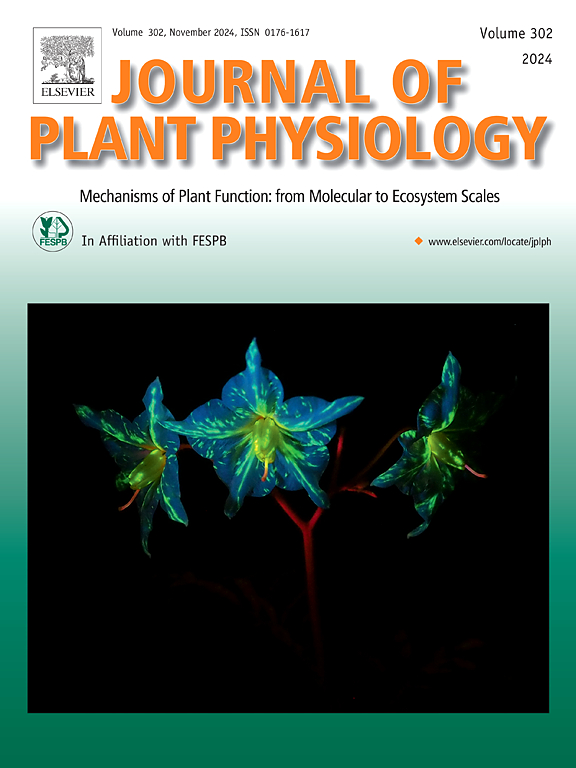Molecular and biochemical analyses of germination of cowpea (Vigna unguiculata L.) seeds inhibited by n-propyl gallate reveal a key role of alternative oxidase in germination Re-establishment
IF 4
3区 生物学
Q1 PLANT SCIENCES
引用次数: 0
Abstract
n-Propyl gallate (PG) is a phenolic compound that influences enzymatic processes, mostly involving AOX, PTOX, LOX, POD, and PPO. Here, analyses of different PG concentrations (1, 2.5, and 5 mM) during cowpea seed germination at 16, 32, and 48h showed that 2.5 mM PG partially inhibited seed germination at 16 and/or 32h, but by 48h the germination re-established. Thus, this PG concentration was chosen to study the molecular and biochemical mechanisms linked to the PG inhibitory effects and germination recovery. PG inhibition was related to lower H2O2, higher antioxidant activity, and downregulation of genes linked to cell cycle progression, energy status, and the Krebs cycle at 16 and/or 32h, but these changes were reversed at 48h. In general, genes associated with detoxification, germination-related phytohormones, and NAD(P)H metabolism were highly up-regulated across the time points. AOX1 and Pgb1 were continuously up-regulated along the time points, and linked to NR transcript level increase only at 48h. These findings indicated that AOX and the phytoglobin cycle, both systems involved in NO levels regulation, worked efficiently in germination re-establishment. However, genes other than AOX associated with potential target enzymes of PG, such as LOX, POD, PTOX and PPO (except at 48h), were mostly unchanged or down-regulated. Genes linked to glycolysis (PFK and PK) and acetate synthesis (PDC and ALDH) connected with AOX via NAD(P)+ were up-regulated under PG mainly at 48h. The data are discussed in light of AOX's role in cell reprogramming to reverse PG-induced inhibition of germination in cowpea seeds.
没食子酸正丙酯抑制豇豆种子萌发的分子生化分析揭示了替代氧化酶在种子萌发重建中的关键作用
没食子酸正丙酯(PG)是一种影响酶促过程的酚类化合物,主要涉及AOX、PTOX、LOX、POD和PPO。在这里,分析了不同浓度的PG(1、2.5和5 mM)对豇豆种子在16、32和48h萌发的影响,结果表明,2.5 mM PG在16和/或32h时部分抑制了种子的萌发,但在48h时萌发又恢复了。因此,我们选择这个浓度来研究与PG抑制作用和萌发恢复有关的分子和生化机制。在16和/或32h时,PG抑制与H2O2降低、抗氧化活性提高以及与细胞周期进程、能量状态和克雷布斯循环相关的基因下调有关,但这些变化在48h时被逆转。总的来说,与解毒、发芽相关的植物激素和NAD(P)H代谢相关的基因在各个时间点上都高度上调。AOX1和Pgb1沿时间点持续上调,仅在48h时与NR转录水平升高相关。这些结果表明,AOX和植物红蛋白循环这两个系统都参与NO水平的调节,在萌发重建中起着有效的作用。然而,除AOX外,与PG潜在靶酶相关的基因,如LOX、POD、PTOX和PPO(除48h外),大多不变或下调。与AOX通过NAD(P)+连接的糖酵解相关基因(PFK和PK)和乙酸合成相关基因(PDC和ALDH)在PG作用下主要在48h上调。根据这些数据讨论了AOX在细胞重编程中的作用,以逆转pg诱导的豇豆种子萌发抑制。
本文章由计算机程序翻译,如有差异,请以英文原文为准。
求助全文
约1分钟内获得全文
求助全文
来源期刊

Journal of plant physiology
生物-植物科学
CiteScore
7.20
自引率
4.70%
发文量
196
审稿时长
32 days
期刊介绍:
The Journal of Plant Physiology is a broad-spectrum journal that welcomes high-quality submissions in all major areas of plant physiology, including plant biochemistry, functional biotechnology, computational and synthetic plant biology, growth and development, photosynthesis and respiration, transport and translocation, plant-microbe interactions, biotic and abiotic stress. Studies are welcome at all levels of integration ranging from molecules and cells to organisms and their environments and are expected to use state-of-the-art methodologies. Pure gene expression studies are not within the focus of our journal. To be considered for publication, papers must significantly contribute to the mechanistic understanding of physiological processes, and not be merely descriptive, or confirmatory of previous results. We encourage the submission of papers that explore the physiology of non-model as well as accepted model species and those that bridge basic and applied research. For instance, studies on agricultural plants that show new physiological mechanisms to improve agricultural efficiency are welcome. Studies performed under uncontrolled situations (e.g. field conditions) not providing mechanistic insight will not be considered for publication.
The Journal of Plant Physiology publishes several types of articles: Original Research Articles, Reviews, Perspectives Articles, and Short Communications. Reviews and Perspectives will be solicited by the Editors; unsolicited reviews are also welcome but only from authors with a strong track record in the field of the review. Original research papers comprise the majority of published contributions.
 求助内容:
求助内容: 应助结果提醒方式:
应助结果提醒方式:


